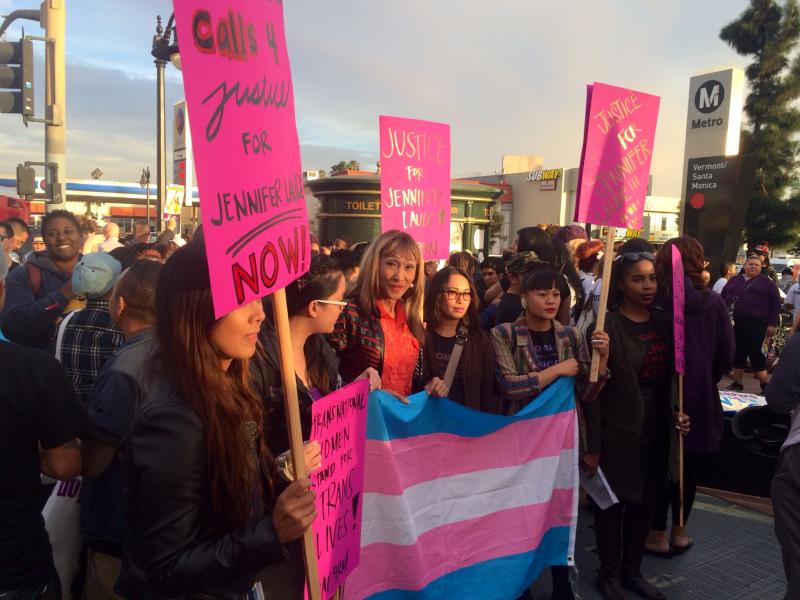LAPD Takes Community Approach In Tackling Transgender Violence

Twenty minutes later, police sirens were heard a couple blocks away approaching the rally, and the protestors dispersed onto the sidewalk in an orderly fashion.
"We're not trying to get arrested," one rally organizer said.
But the sirens came and went, and no confrontation ensued — in fact, quite the opposite. A LAPD cop car drove slowly by, honking at the demonstrators with a thumbs up. A pair of officers stood on the sidewalk, conversing with a protester about the goals of the rally. Motorcycle cops stood by on alert, without intruding.
These actions, strides away from the stereotypes of excessive force that have riddled the LAPD in the past, are signs of a department that is trying to build a relationship with a community that stands as a major target for violence.
“One of the gaps we have with our transgender community is their lack of trust overall,” said LAPD Assistant Chief Sandy Jo MacArthur. “There’s still a lot of mistrust — if they call the police, will the police be responding? Will they be treated with respect? Will [officers] be recognizing certain types of crimes, such as hate crimes?”
MacArthur, who is currently in charge of a working group made up of LAPD officers and transgender organizations, is trying to change that narrative and foster a greater dialogue between the two communities.
READ MORE: Transgender Rally Shuts Down Intersection In Hollywood, Demands End To Violence
Formed last spring, MacArthur’s working group held its first LGBTQ community forum at LAPD headquarters in early November to hear complaints from the community, and determine where the department’s weaknesses are.
“This helps me because our community members can bring forward what their concerns are,” MacArthur said. “It helps me assess where I can focus and what I need to focus on.”
Participants discussed various issues — particularly the fear of entrapment by the department’s Vice division and the improper reporting of hate crimes.
The latter is especially noteworthy — hate crime statistics released by the Los Angeles County Commission on Human Relations in October revealed that the number of incidents against transgender individuals increased by 46 percent between 2012 and 2013— from 13 to 19. But as brought up by community members, many are feared to go underreported.
“We can’t get the law enforcement to put things in the hate crime category where it belongs,” said transgender advocate Michaela Ivri.
A rallying point for many transgender advocates and Ivri’s point of reference is the case of Aniya Parker, a 46-year-old transgender woman who was murdered October in East Hollywood following what the department said was an attempted robbery. Many in the transgender community, however, stressed that this incident should have been reported as a hate crime, and MacArthur recognizes these complaints.
“We realize that we alienated some transgender individuals in the community regarding that case,” she said. “[Because of this,] I immediately got involved with some of my transgender advocates and we started to say, ‘Okay what do we need to do to change this.’”
It is this strategy — of identifying specific weaknesses and places for improvement — that serves as the stimulus for increased department training, a major element of MacArthur’s strategy to improve relations between LAPD and the transgender community.
In particular, she mentioned that proposed solutions to the issue are increased training for officers regarding hate crimes, such as making sure they're asking the right questions to determine if the case was motivated by hate, as well as encouraging community members to report something if they believe it to be hate crime, whether directly to the LAPD or to affiliated advocacy organizations that can then report to the department.
The continued frequency of such issues reveal that MacArthur’s mission may still be an uphill battle. Karina Samala, a transgender advocate who is a member of MacArthur’s working group, stressed that there is still room for improvement in police-transgender communications.
“I’m so glad that the relationship between the LAPD and the transgender community has changed a lot, but there’s still a lot more work that needs to be done,” said Karina Samala, “The disrespect is there still and profiling’s very prevalent — it’s sad to see.”
Recent history, however, has shown that the department is open and willing to change from within. In the past few years, workings between the transgender community and the LAPD have resulted in concrete policy.
The professional relationship between the two communities began in 2012, when in conjunction with the Los Angeles Human Relations Commissions Transgender Working Group and the Mayor’s Office, the department instituted two new policies regarding police interactions with transgender individuals. The first required that officers must respect the expressed gender of the apprehended, no matter what is stated on their official identification, and the second mandated a separate holding cell in city jails for transgender individuals.
Though policy and officer behavior can be two different things, it is still the start the transgender community has been looking for.
“At least we’re talking, at least we’re building a relationship with the LAPD and the community,” Samala said. “Now we have this dialogue for them to have a better understanding of our community, our issues and our needs so we are treated just as equally as other communities.”
Reach Staff Reporter Matt Lemas here.



